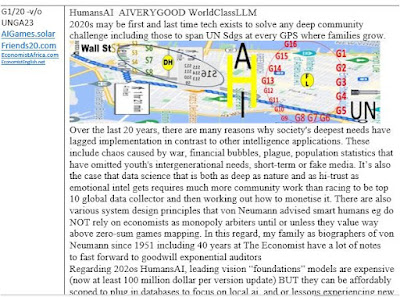Chapter 4 Education
designed to value's the (girl/boy) child's life, love of self, collaborative
teamwork, communal dignity of everyone as an action learner and livelihood
co-creator
Most of 21st
Century brac’s hundred thousand people are skills trainers distributed across rural
Bangladesh who value Paulo Freire culture of service learning -indeed St Francis’
quest that female followers practice community health servants and male followers
celebrate being nature’s deepest connectors; of course, here are a few
engineers too; but I can’t remember having met a bureaucrat in the organization
that Abed facilitated. Nowhere is data deeper than when you ensure you are
always searching out what the poorest need to be included in the future
Frankly speaking the foundation
of brac around skills trainers started from Abed’s biggest mistake. As one of Asia’s
leading young engineers, in 1972 he used his life savings to build 15000 homes
for 100000 people whose region had been flattened by the war of independence. Bangladesh
is a crowded nation but in other ways Abed’s metavillage 5.1 was one of the
most disconnected space in the tropics. No electricity, no engines of any kind.
No sooner than this
was built than Abed found dozens of women were dying each week of starvation;
scores on infants were dying from dehydration. The desperate “educational” need
was to develop business micro franchises in food production and last mile
health services- and to train village mothers to operate these with positive
cash flows however small but compounding positively
Thus 4.1 WOMENS LIVELIHOOD
TRAINING – Through microfranchise design 1.1 and training village mothers’
productive community building to end poverty and actioning sustainability goals
started what has become civil society’s most collaborative and largest 21st
C partnership network
Bangladesh was born 8th
largest and poorest nation 90% rural ie villagers without access to
electricity. So women empowered action learning networks were all person to
person. About 15 years into Bangladesh’s development village mothers could
afford to demand village schooling for their children.
4.2 PRIMARY Brac built the largest non-government primary
school system – over 40000 one room schools in little more than a decade. Village mothers operated these schools using
brac’s own learning materials. Above all Abed designed in a loving environment
for kids t experience but at age 11 moist outperformed city schools run by the
government. Designing many children’s only 6 years of learning made it important to
add in “missing curricula”: financial literacy is paractised at 2nd
grade onwards; because brac village mothers deliver most of the last mile
health services, health and safety practices are bult into the culture of being
a brac student.
4.3 PARTNERS IN SECONDARY
– GIRLS JOBS APPRENTICESHIPS PLUS. For various reasons including millennium goals focus on primary
schools, Abed could not assemble funds fordesigning secondary schools. Instead
he built mainly girls apprentice clubs to partner libaries as well as secondary
school scholarships. Brac’s community culture maximised livelihood support for
children/families that it linkedin
4.4 UNIVERSITY. 1996: In the second quarter of a century of
Brac and Abed’s work tech partners in the form of solar, mobile started to come
to the villages. Abed started up brac university. Everything brac and village
women empowered networks could be updated there, and much more including the
request probably first made by Mrs Stave Jobs that Abed work out which of Bangladesh
women’s solutions could be extended to other countries. So, while the
university aimed to be sustainability’s best national university, abed wanted
to design solutions that graduates of collaborative sdg universities could
apply the world over.
4.5 ECP. Early Childhood
Playschools were a gap in education
all over the world. So, brac university offered Asia’s first masters in ECP.
Giving children the earliest experience of a loving space to developm has
special advantages in places brac works from the poorest villages to refugee
situations. Partners in Early Childhood Playschools can bring world class psychological
inputs; and indeed, clarify why brain science supports action learning as the
most effective method in so many skills from arts to computer coding to microentrepreneurship.
4.6 Luminaries of Education,
Collaboration and Urgent Sustainability Generation. Anything humanity doesn’t yet know how to do-
including living sustainably with nature- can only be massively solvable by
Education. Before he died, Abed passed on the idea if education luminaries to Hong
Kong and tech billionaire Charles Yidan and his newly emerging 4-hemispher
education foundation: Yidan Prize & Yidan Luminaries. Luminaries connect
practitioners if education with practitioners of anything that can be a
solution youth need to be the first SD Generation. each year as well as celebrating
new prize winners, luminaries are connecting 4-hemisphere stages for celebrating
advances of 360 degree education – today and discipline including tech wizards can
positively interact with bringing up the younger half of the world as first SDG
generation. For example, Yidan’s director of partnerships is also entrepreneur
in residence at Stanford. From Bangladesh to Hong Kong to Stanford to Cambridges
(Boston and England) to Oxford to Wuhan let girls and boys joy of co-creating
shine.





